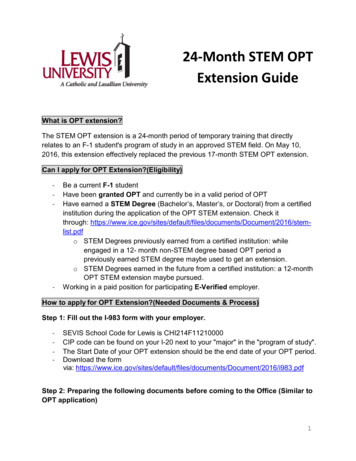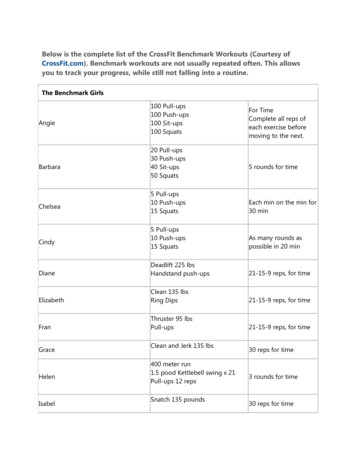
Transcription
Horizontal Benchmark Extension for ImprovedAssessment of Physical CAD ResearchAndrew B. Kahng†‡ , Hyein Lee† and Jiajia Li†† ECEand ‡ CSE Departments, University of California at San DiegoLa Jolla, CA, 92093abk@ucsd.edu, hyeinlee@ucsd.edu, jil150@ucsd.eduABSTRACTThe rapid growth in complexity and diversity of IC designs, designflows and methodologies has resulted in a benchmark-centricculture for evaluation of performance and scalability in physicaldesign algorithm research. Landmark papers in the literaturepresent vertical benchmarks that can be used across multiple designflow stages; artificial benchmarks with characteristics that mimicthose of real designs; artificial benchmarks with known optimalsolutions; as well as benchmark suites created by major companiesfrom internal designs and/or open-source RTL. However, to ourknowledge, there has been no work on horizontal benchmarkcreation, i.e., the creation of benchmarks that enable maximal,comprehensive assessments across commercial and academic toolsat one or more specific design stages. Typically, the creation ofhorizontal benchmarks is limited by mismatches in data models,netlist formats, technology files, library granularity, etc. acrossdifferent tools, technologies, and benchmark suites. In this paper,we describe methodology and robust infrastructure for “horizontalbenchmark extension” that permits maximal leverage of benchmarksuites and technologies in “apples-to-apples” assessment of bothindustry and academic optimizers. We demonstrate horizontalbenchmark extensions, and the assessments that are thus enabled,in two well-studied domains: place-and-route (four combinationsof academic placers/routers, and two commercial P&R tools) andgate sizing (two academic sizers, and three commercial tools). Wealso point out several issues and precepts for horizontal benchmarkenablement.1.INTRODUCTIONScaling of integrated system complexities, along with rapidchanges in both SOC architectures and underlying processtechnologies, continue to demand improvements of VLSI CADalgorithms and tool capabilities. Particularly in the academicresearch context, benchmarks have been widely adopted as thebasis for evaluation and comparison of VLSI CAD algorithmsand optimizations [1] [21]. Evaluations mainly focus on solutionquality and runtime; optimization domains include synthesis,partitioning, placement, clock tree synthesis, global routing, gatesizing, and other aspects of IC implementation. Since themid-1980s, various benchmark suites and methods for artificialbenchmark generation have been published, as reviewed inSection 2 below [4] [3] [2] [7] [9] [15].At a high level, benchmarks in VLSI CAD (and, specifically,physical design) may be classified as real (derived from actualdesigns), artificial (intended to mimic aspects of real designs, andoften the product of parameteriable generators), and artificial withknown optimal solutions (realistic, but with optimal solutionsembedded in the benchmark construction). On the other hand,vertical benchmarks [14] explicitly seek to enable evaluation ofPermission to make digital or hard copies of all or part of this work for personal orclassroom use is granted without fee provided that copies are not made or distributedfor profit or commercial advantage and that copies bear this notice and the full citationon the first page. Copyrights for components of this work owned by others thanACM must be honored. Abstracting with credit is permitted. To copy otherwise, orrepublish, to post on servers or to redistribute to lists, requires prior specific permissionand/or a fee. Request permissions from permissions@acm.org.GLSVLSI’14, May 21–23, 2014, Houston, Texas, USA.Copyright 2014 ACM 978-1-4503-2816-6/14/05 . D tool performance across a span of several flow stages, viarepresentations at multiple levels of abstraction.For nearly three decades, VLSI CAD benchmarks, and their use,have faced the same quandary. Essentially, “leading-edge”, “real”designs embody high-value intellectual property of their creators,and cannot be easily released; “old” or “artificial” benchmarkspotentially drive CAD research in stale or wrong directions. Thus,when “real” benchmarks are released to the academic researchcommunity, their influence can be enormous, as was seen with theISPD98 partitioning benchmark suite from IBM [2]. Further, thedifficulty of obtaining real, leading-edge designs as open driversfor research raises an obvious challenge: How can we maximallyleverage available benchmarks as enablers of (physical) CADresearch?To our knowledge, no previous work pursues the maximalassessment of academic research and its prevailing industry context(i.e., across various process/library technologies, benchmarkcircuits, and tools), at one or more particular flow stages, whilesuch maximal assessment would reveal tools’ suboptimality, andthus guide the improvements of tools’ quality. Such “horizontal”evaluations are usually blocked by gaps between data modelsand formats of academic benchmark suites, versus those used inindustry CAD tool flows.1 Many benchmarks are constructed forparticular technologies with specific library [36] granularity andnaming conventions, which limits assessment. Underlying problemformulations may be mismatched to industry use cases, furtherhampering assessment.In this work, we pursue the goals of horizontal benchmarks andbenchmark extension, which together seek to maximize “applesto-apples” assessment at one or more particular design stages,across different benchmarks, technologies, and tools. We use sizingand P&R (placement and routing), which are the topics of recentISPD contests, to illustrate the challenges of, and our resultingmethodologies for, horizontal benchmark enablement.Forbenchmarks, we report transformed sizing-oriented benchmarks(i.e., ISPD12/13 [18] [19]), placement-oriented benchmarks (i.e.,ISPD11 [25]) and real designs (from OpenCores [37]). Fortechnologies, we show mappings across ISPD12/13 contestand 28/45/65/90nm foundry technologies. Given the resultinghorizontal benchmark suite, for tools we demonstrate the feasibilityof apples-to-apples assessment among two academic sizers andthree commercial tools in the sizing domain, and among fouracademic P&R tools and three commercial tools in the P&RComparison to commercial tools allows a betterdomain.assessment of academic tools’ capability. The scope of our effortsis depicted in Figure 1. The website [28] gives all conversionscripts, tool runscripts, and horizontal benchmark datasets that wedescribe in this paper.We make several high-level observations. First, our workdoes not simply convert data formats to be used across differenttools.Rather, we address at a number of levels the keychallenge of horizontal benchmark enablement, namely, howmissing information can be reasonably filled in, and/or which1 We recognize and applaud initiatives such as OpenAccess [39] and the now-inactiveOAGear [40]. These data model and infrastructure projects offer the promise ofuniversal data model and ‘star topology, rather than clique topology’ of interfaces andconverters. However, given the long-standing incompleteness of open data models(e.g., with respect to timing flows) as well as the small number of key targets (ISPDbenchmark formats, LEF/DEF and Verilog standards) we take a less elegant, and morepragmatic and brute-force, approach to achieving the desired enablement.
Figure 1: Scope of this work. We enable extensive assessmentacross different technologies, benchmarks and tools.information should be simplified or hidden from tools, such thatuseful studies become possible. Second, the deeper contributionof our work is in enabling new questions to be explored: Canwe better assess academic solver quality and scalability, in orderto better assess potential gaps between the leading edge ofacademic research and industry contexts? Third, we emphasizethat throughout our paper we use the term “benchmark” as a noun,and not as a verb. Our work is in the same spirit as OAGear [40],the GSRC Bookshelf [46] and works such as [5] – i.e., we hope thathorizontal benchmarks will help industry and academia identify themost fruitful targets for academic research, as well as the potentialimpact of new academic research results.2Our contributions may be summarized as follows. We propose and demonstrate horizontal benchmarksthat allow maximum leverage of industry-providedbenchmark data,and maximal “apples-to-apples”assessment of academic research tools in industrycontexts (hence, technology evaluation and transfer)across benchmarks, technologies and tools, which willprovide indications to designers on how to improve theirtools’ robustness/performance. We enumerate a number of challenges in horizontalbenchmark creation, along with our solution approaches. We demonstrate the feasibility of apples-to-applesassessments in the P&R and sizing domains, using arich mix of academic benchmark and real design data, fourdistinct process technologies, and a number of academic andcommercial optimizers. Our infrastructure for horizontal benchmark extension andenablement (conversion scripts, tool runscripts, mappedbenchmarks) is available on the web [28] for use by industryand academia.The rest of this paper is organized as follows. Section 2briefly reviews related work on academic benchmark suites andgenerators. In Section 3, we describe issues and challengesof horizontal benchmark enablement – both general issues, andissues specific to P&R or sizing – along with our solutionapproaches. Section 4 describes our experimental setup and resultsthat demonstrate the feasibility of horizontal assessment in the P&Rand sizing domains. Section 5 gives our conclusions and someperspectives on broader issues pertaining to horizontal benchmarkenablement.2.RELATED WORKSPrevious literature on benchmark generation (a recent reviewis given in [21]) addresses two main categories of benchmarks.Real benchmarks are derived from actual (but not too recent,for IP protection reasons) industrial designs. Figure 2 showsgate count over time in largest MPU products (per the 2011ITRS [33]) and in largest circuits of notable benchmark suites.Superficially, gate counts in real designs have increased by 22 since 1998, while over the same 15-year period the gate countof the largest benchmark netlists has increased by 12 ; there iscurrently still a “1000 ” gap (indicated by the scale difference2 We do not advocate “benchmarking” (the verb) or any other activity that is inviolation of commercial tool licenses.between two y-axes). More realistically, the gap between academicbenchmark and real design complexities can be estimated (basedon gate count) at 5 20 , when we calibrate to individualhard macros and top-level netlists in modern SOCs, or flat ASICdesigns.3 Artificial benchmarks are algorithmically generated,typically for a specific field or problem domain such as row-basedplacement or power grid analysis. The primary concern in artificialbenchmark generation has been to capture salient attributes of realdesigns, such that academic CAD research is appropriately drivento intercept future industry needs. Thus, artificial benchmarkshave attempted to match such parameters of real designs as Rentexponent, fanin/fanout distribution, path depth, etc. Importantdirections have included randomization techniques, and methods togenerate artificial benchmarks with known optimal solutions. Webriefly review examples of each benchmark type.Year#MtranReal Designs 119348250 KITRS 2002200224360750 K200330776750 KITRS 200410000000Gate Count (K)Gate Count (K)ISPD06ISPD05ISPD11200438696500 K200538696500 KITRS 100000100ISCAS89Real Designs (ITRS)100001000198510Benchmark SuitesISCAS85119901995200020052010Figure 2: Gate count trajectories of largest MPU products [33] andlargest designs in benchmark suites. Data in blue use the left y-axis,and data in red use the right y-axis.Benchmark Suites Based on Real Designs. The highly influentialMCNC benchmark suites [3] [4], published in the 1980s, havebeen used in various CAD applications such as automatic testpattern generation (ATPG), logic synthesis, netlist partitioning, andplacement. The largest instance in the ISCAS-89 benchmark suitehas 70K gates and 3K flip-flops. The ISPD98 benchmarksuite [2], developed for netlist partitioning applications, includes18 circuits with module counts up to 210K. Since the benchmarkcircuits are generated from IBM internal designs, functionality,timing and technology information is removed. The ITC99benchmark suite [10] from the same time frame contains both RTLand gate-level benchmarks, the largest of which has 200K gatesand 7K flip-flops, targeted at ATPG algorithm evaluation.Over recent ISPD contests, the ISPD05 and ISPD06 benchmarks[31] respectively afford up to 2.1M and 2.5M placeable modulesin the mixed-size placement context. The ISPD11 suite [25]is derived from industrial ASIC designs and aims at routabilitydriven placement; it goes beyond earlier placement benchmarks byintroducing non-rectangular fixed macros and associated pins thatreside on metal layers, with up to 1200K modules (standard cells,macros and IO pins). For gate sizing and Vt-swapping, the ISPD12benchmark suite [18] adds library timing models (.lib, or Libertytable model format [36]) for a cell library with 11 combinationalcells (each with 3 Vt variants and 10 sizes) and one sequential cell,along with a simplified SPEF with a single lumped capacitance foreach net. The ISPD13 suite [19] adds more detailed RC modelingand incorporates an industry timer in the evaluation. Instancecomplexity reaches 982K instances.Artificial Benchmark Suites. Previous artificial benchmarkgeneration approaches include circ/gen [13], gnl [22] and the workof [11]. A valuable class of methods produces instances with knownoptimal solutions. The PEKO placement benchmark generator [7]achieves a net-degree distribution similar to (ISPD98) IBM netlistsas well as a constructive placement solution with known minimumwirelength. To improve realism (PEKO benchmarks have a singlecell size, and all nets are local), PEKU [9] generates instanceswith known upper bounds on optimal wirelength. Nets in PEKUinstances are long; a hybrid of PEKO and PEKU allows users tospecify the percentage of short nets in the benchmarks. Generation3 There may be a chicken-egg dynamic here: growth of hard macro gate counts in SOCdesigns is limited by scaling of capacity (i.e., QoR/runtime sweetspot) of EDA tools,which has slowed in recent years.
ISPD-12/13(.v netlist)of artificial instances with known optimal solutions has also beenachieved for gate sizing optimizations [12]; an extension in [15]produces instances that resemble real designs in terms of gatecount, path depth, fanin/fanout distribution and Rent parameter.3.Determine flip-flopsMap cells based on pin#/sizesCHALLENGESTechnology migrationWe now discuss challenges of horizontal benchmark extension,focusing on recent ISPD suites and actual designs.4Themost obvious challenge in benchmark extension, arising from IPprotection and limited scope of target problem formulations, isthat benchmarks typically omit information. Partitioning instances(ISPD98) omit cell sizes and signal directions; placement instances(ISPD06/11) omit/obfuscate cell functions and combinationalsequential distinctions; global routing instances (ISPD07/08) omitcell functions and pin locations; etc. Thus, we must make a numberof judgment calls as to how to best fill in missing informationto achieve “benchmark extension”. To (i) enable academic andindustry optimizers to be run on the same testcases, and (ii) extendplacement benchmarks to sizing benchmarks, we are faced withmany options. These include, for example, criteria for mapping aplaceable cell in a placement benchmark to a timable cell in a sizingbenchmark; setting of timing, max fanout and other constraints;creation of interconnect parasitics; etc. The exemplary issuesshown in Table 1 are addressed in the next three subsections.Table 1: Sample issues in horizontal benchmark enablement.IssueA1A2B1B2C1C23.1SummaryMissing logic function information in ISPD11 benchmarksNeed timable benchmarks with parasitic information for sizingCommercial tools handle richer constraints and design rulesISPD12/13 technology does not provide LEF fileCommercial sizers require timing-feasible benchmarksGranularity of libraries varies across different technologiesFormats, Data Models, and LibrariesWe illustrate horizontal benchmark extension using selectedinstances from the ISPD11, ISPD12 and ISPD13 benchmark suites,along with two designs from the OpenCores website [37]. The firstchallenge is different formats (see Table 2): ISPD11 benchmarksare in Bookshelf format [46], ISPD12/13 benchmarks are .vnetlists (i.e., structural Verilog), and real designs are described asRTL. Further, cell function information is removed from ISPD11benchmarks. To enable horizontal assessment, our solution mapsall benchmarks to .v netlists, which enables us to synthesizereal implementations in arbitrary technology libraries; for ISPD11benchmark circuits, we map nodes to cells in a given targettechnology. Apples-to-apples assessment in the P&R domain thenrequires us to also generate DEF [35] by performing floorplanning,power planning, and placement of primary inputs and outputs.Table 2: Data formats/models for ISPD benchmark typesDesign stagePlacementGlobal micCommercialAcademicRequired file format.v, .lib, (DEF), LEF.nodes, .nets, .wts, .pl, .scl, .shapes.v, .lib, DEF, LEF.gr or .nodes, .nets, .pl, .scl, .shapes, .route.v, .lib, DEF, LEF, SPEF, .sdc.v, .lib, SPEF, .sdcA second basic challenge in horizontal extension is thatmany academic tools are “hard-wired” to particular technologydefinitions. When assessing “legacy” tools that are no longerunder active development, extra stpdf of enablement are requiredto migrate benchmarks across multiple technologies. For example,different cell libraries might vary in granularity (number ofcell sizes, number of Vt flavors), available logic functions, ornaming conventions, and this makes technology migrations not sostraightforward. Figure 3 depicts our flow to extend benchmarkshorizontally across multiple technologies. Explanations of sampleissues (shown in Table 1), and our corresponding approaches, areas follows.54 In our experience, horizontal extension of artificial, as opposed to real, netlists doesnot bring any fundamentally different challenges. Thus, while our discussion belowfocuses on real instances, it is largely orthogonal to the real vs. artificial dichotomy.5 Due to space constraints, more complete documentation is given at [28].ISPD-11 (Bookshelf)ISPD11 (.v netlist)Real (RTL)LibertySynthesisDRC fix (e.g., max. fanout)Remove logic redundancyBenchmarks (.v netlist)FloorplanIO placementPowerplanBenchmarks (.DEF)(for placement)Floorplan / IO placement / PowerplanPlacement / RoutingParasitic extractionBenchmarks (.SPEF, .DEF)(for sizing)Figure 3: Flow to extend benchmark circuits across technologies.Issue A1: In ISPD11 benchmarks, logic function informationis removed and only node (i.e., cell, macro, pin) sizes andconnectivity information are provided. To address this issue, ourapproach maps nodes of a placement benchmark to cells in agiven Liberty/LEF pair, based on cell pin count and cell width.We first determine sequential cells.6 We then map other nodesto combinational cells in the given LEF based on cell width andpin count. We normalize widths of nodes with the same pincount in the benchmarks to a particular range (e.g., [0, 1]). Then,we normalize cells with the corresponding pin count to the samerange. Based on the normalized width values, we randomly assigncells from Liberty to nodes of the ISPD11 benchmark. Sincewe do not consider design functionality during cell mapping,logic redundancy can result, and we therefore use Synopsys DCCompiler [42] to simplify the netlist with Boolean transforms.When we migrate a resulting benchmark to another technology, wepreserve functionality but scale footprint accordingly.Issue A2: Timing paths are not considered in placementbenchmarks. For instance, there are many floating nets (i.e., drivingcell information is missing), notably in ISPD11 benchmarks,which lead to unconstrained timing paths. In addition, parasiticinformation is missing in placement benchmarks. Our approachadds additional primary inputs, to which we connect the floatingnets. We determine the number of additional primary inputsbased on Rent’s rule (we use a Rent exponent value of 0.55 inthe implementations reported below), and distribute floating netsevenly to the additional primary inputs. Further, we perform loweffort placement and routing and extract parasitic information fromthe routed designs.3.2Enablement of P&R AssessmentsFigure 4 shows our enablement of P&R assessments. The inputsof the standard industry flow are LEF, DEF (or .v) and Libertyfiles. Conversion between LEF/DEF and Bookshelf formatsenables assessment across commercial and academic tools. Weimplement placement with both commercial and academic placers;we then perform global routing on the resultant placement solutionsusing both commercial and academic tools. Detailed routingis feasible only with commercial tools. To enable apples-toapples assessments across academic and commercial tools, wemodify technology files and apply conversions between differentformats. Explanations of sample issues (shown in Table 1), and ourcorresponding approaches, are as follows.Issue B1: Commercial tools have multiple objectives andneed to satisfy many design rules (e.g., antenna and maximumcurrent density rules) and constraints (e.g., multi-mode/multicorner timing, maximum fanout, etc.) while academic tools haveonly a specific objective. Our goal is to compare performancein terms of the specific objective, not to compare overall toolquality. In light of this goal, our approach intentionally drives thecommercial tools to optimize for a specific objective that we want6 Given that area of a flip-flop is typically 5 the area of a NAND gate of similardriving strength, we bucket nodes having width of 25-32 units as flip-flops in ISPD11benchmarks. Our identification of sequential cells has been confirmed by checkingagainst a golden list of sequential cells provided by contest organizers [25].
Simplified foundry LEFFabricated ISPD LEFBenchmarks (.DEF)LibertyConvert to Bookshelf formatBenchmark (Bookshelf)Place with academic placersPlace with commercial placersBookshelf GRDEF/LEF Bookshelf GRBookshelf LEF/DEFLiberty, but a different number of sizes in a foundry Liberty. Thiswould lead to less consistent results across technologies due tothe changed solution space; thus, it is difficult to assess tools’quality across technologies. To match the number of cell variants,our approach increases library granularity so that all differenttechnologies have the same sizing solution space. We generate newcells by interpolating/extrapolating based on timing information(cell delay, output transition time) of existing cells, exploitinglogical effort analysis for cells of each given type. Last, weapproximate leakage power and pin capacitance values by fittingsecond-order models to the values of existing cells.4.Global route with academic routersGlobal route with commercial routersDetailed route with commercial routers.SDCFigure 4: Enablement flows for horizontal P&R assessment.to evaluate, by removing various extraneous rules that are definedin the LEF file. We use the simplified LEF file in placement androuting with both academic and commercial tools.Issue B2: No technology (LEF) file is provided with ISPD12/13benchmarks. To enable P&R of ISPD12/13 benchmarks usingcommercial tools, our approach constructs a new LEF file thatincorporates technology information (e.g., metal pitch, width) fromthe foundry LEF. To generate cell LEF, we extract the pin area ofX1 cells in the foundry LEF; based on this, we generate rectangularpins with the same area and height. Currently, we only distributepins evenly inside each cell – then, based on the generated X1 cells,we scale width, pin area and on-grid pin locations linearly withdrive strength to derive the LEF for larger cells.73.3Enablement of Gate Sizing AssessmentsWe also enable horizontal evaluation across academic andindustry tools for gate sizing (i.e., post-routing leakage reduction),as depicted in Figure 5. The cell sizing/Vt-swapping optimizationreduces leakage while preserving a timing signoff.Whilecommercial tools can consider, e.g., an area increase constraint,to achieve a fair assessment we only study tools in a pureleakage minimization use context. Inputs to sizing tools are netlist(.v), interconnect parasitics (SPEF), timing constraints (.sdc) andtiming/power Liberty (.lib).EXPERIMENTAL RESULTSWe experimentally validate our horizontal benchmarkenablements in two ways: (i) P&R studies; and (ii) sizingstudies. In each way, we first assess tools’ performance ondifferent benchmarks, then, in different technologies. Last, weselect the largest benchmark in each domain and perform maximalcomparison, where we compare among different technologies andtools. Our studies use benchmark circuits with multiple sourcesand original purposes, as listed in Table 3. We use five distinct:ISPD12/13, and foundry 28nm FDSOI, 45GS, 65GP, and 90LP.Table 3: Benchmark ISPD12-1ISPD11-1ISPD11-2ISPD11-3Real-1Real-24.17 Particularly for mapping to advanced ( 28nm) foundry technologies, we recognizethe need to improve awareness of porosity, pin accessibility, and related considerations.Gate Count 26183241473986Gate Count 8588283241473986P&RWe perform horizontal assessments using both academic andcommercial P&R tools, across five technologies. Table 4 listsour experiments, where cPlacer1, cPlacer2 and cRouter1 are P&Rfunctions (mapping not given here) in Cadence SoC EncountervEDI13.1 [30] and Synopsys IC Compiler vH-2013.03-SP3 [41].Table 4: Apples-to-apples assessments in P&R domain.Expt 1Expt 2Figure 5: Enablement flows for horizontal sizer assessment.Issue C1: Academic tools developed for the ISPD12/13 gatesizing contests must perform timing legalization as well as leakageminimization with a fixed set of SPEF parasitics, since notiming-feasible solution is provided. On the other hand, theuse model for commercial “post-route leakage recovery” tools isto preserve a timing signoff (with fixed SPEF from a completedetailed route) while minimizing leakage. In other words, theindustry tools assume a starting timing-feasible solution. Fora fair assessment, we obtain timing-feasible solutions for alltestcases. Our approach uses the academic tool [17] to performtiming recovery and changes .sdc files to generate timing-feasiblesolutions.Issue C2: For assessment across different technologies, we wouldlike to ensure that input netlists and sizing/Vt solution spaces arepreserved across technologies. Varying library granularity posesa challenge, e.g., there are 10 sizes of inverters in ISPD12/13Namedes perfnetcardcordicmatrix multb19superblue1superblue12superblue18jpeg encoderleon3mpBenchmarkISPD13-{1-4}, ISPD12-1,ISPD11-{1-3},Real-{1-2}ISPD13-2, ISPD11-2Expt 3ISPD11-2Expt 4ISPD13-2TechTool28nmcPlacer1, mPL6ISPD,28/45/65/90nmcPlacer1, mPL6cPlacer1, cPlacer2,ISPD, 28/65nm cPlacer3, NTUPlace3,mPL6, FastPlace3.1cPlacer1, mPL6,28nmcRouter1, BFG-R,Expt 1 assesses solution quality (HPWL) and runtime of onecommercial placer and one academic placer, using circuits fromISPD11/12/13 benchmark suites and real designs, with foundry28nm technology. Results in Table 5 show that the academic toolachieves better HPWL, but consumes more runtime especially onlarge benchmarks. For a “fair comparison”, awareness of timingand electrical design constraints is disabled in the commercial tool,where these issues (timing, DRVs) are not yet well-considered byany academic placers.Expt 2 assesses placement solutions of one commercial placerand one academic placer across five different technologies. Resultsin Table 6 again show the academic tool in most cases achievingless HPWL with larger runtime, consistently across technologies.Expt 3 illustrates horizontal assessment across two commercialand three academic placers, and across three distinct technologies,using the ISPD11-2 benchmark. Results in Table 7 show thatsolution quality is fairly consistent in the commercial tools, butvaries more widely across the academic tools. More critically, thetool rankings that might be inferred using the ISPD technology arequite different from those that might be inferred in 28nm and 65nmtechnologies, which raises the possibility of greater suboptimalityfor academic tools in industry technologies.
Table 7: Expt 3. Comparison across placers. Benchmark: ISPD11-2. “-” indicates that no feasible solution is obtained within 48 m)(min)473001330-Table 5: Expt 1. Placer assessment across benchmark circuit types.cPlacer1mPL6Benchmark HPWL Runtime HPWL -1954108006Real-22940027317600268Table 6: Expt 2. Placer assessment across 5030026336400328426003075880033578600449mPL6HPWL
rich mix of academic benchmark and real design data, four distinct process technologies, and a number of academic and commercial optimizers. Our infrastructure for horizontal benchmark extension and enablement (conversion scripts, tool runscripts, mapped benchmarks) is available on the web [28] for use by industry and academia.










